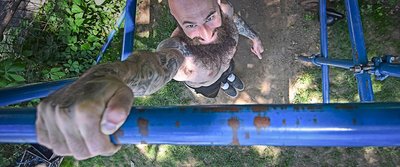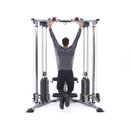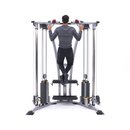My one-arm pull-up journey began nearly a decade ago, immediately after I first saw one performed in person. Prior to that, I'd heard stories—legends, really—about the move, but never believed it was truly possible. The only time I'd ever witnessed someone do a pull-up with one hand was when the other one was wrapped around their wrist. Contrary to my initial expectation, however, a true one-arm pull-up is in fact possible.
In addition to achieving the one-arm pull-up on a few occasions myself, I've had the privilege of coaching some very strong people to perform their first one-armer as well. Though there are always many paths to any destination, I've concluded through my own trials and errors that the following techniques and tactics are the most essential, should you hope to one day tame this wicked beast of an exercise.
Pull-ups for Days
Before you begin working toward a one-arm pull-up, I urge you to spend plenty of time getting comfortable with the two-arm variety. Focus on getting to the point where you can perform at least 15 clean overhand pull-ups in one set without using momentum. Ideally, you should do closer to 20. This is the foundation for your one-arm pull-up.
Once you've got that foundation, your next task is to get comfortable hanging on the bar with just one arm. This requires a serious amount of grip strength as well as strong, stable shoulders. If you can do 15 good pull-ups, you should pretty much be there already, but some dedicated practice is still necessary.
Focus on keeping your lats and shoulders engaged while you hang. In the beginning, just holding on for a few seconds may be very challenging. Eventually, you can work up toward longer one-arm hangs. A 30-second one-arm hang is a good target to aim for before moving ahead to anything more ambitious. If you have access to monkey bars, I also recommend practicing swinging across them for additional single-arm shoulder-stability work.
Flex Hangs and Negatives
Just like a beginner would learn to do a two arm pull-up by performing a flexed arm hang or "flex hang" at the top of a pull-up, the first step towards doing a one arm pull-up is practicing a one-arm flex hang.
Starting at the top position of a pull-up with your chin above the bar, brace your entire body and carefully remove one hand. I suggest practicing this move with an underhand grip, as doing so allows you to keep the bar near the center of your body, which will make for better leverage. Though the burden of supporting your entire body weight appears to rest solely on one arm, your chest, lats, and abdominals are also an important part of the equation.
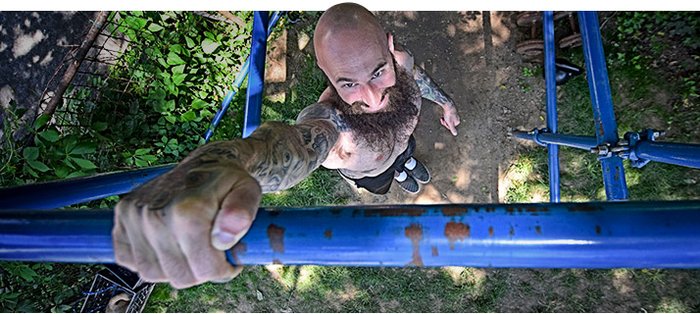
Before you begin working toward a one-arm pull-up, I urge you to spend plenty of time getting comfortable with the two-arm variety.
The first time most people try a one-arm flex hang, they immediately fall as soon as they take the other hand away. Don't be discouraged if that happens to you during your first few attempts. To help stay up, don't just think about your arm; focus on squeezing your whole body tight, especially your abs. You may find it helpful to keep your legs tucked close to your trunk when starting out. Eventually, work toward holding the position with your legs extended.
Once you can hold the top position of a one-arm flex hang for several seconds, you can begin to work toward a controlled one-arm negative. The idea is to start from a one-arm flexed hang position, then carefully lower yourself into a dead hang with as little momentum as possible. Performing the eccentric phase of the one-arm pull-up is a great way to prepare your tendons and ligaments for the stress of the full move while simultaneously training your central nervous system to acclimate to the unusual movement pattern.
The first time you try to do a one-arm negative, you will probably drop like a stone again. When starting out, it may help to not even think of it as a negative; just try to keep yourself up and let gravity take care of the rest. The closer you get to a full hang, the harder it becomes to maintain control during the descent. Be prepared to spend a lot of time on this step. You'll need to own every inch of the negative!
Give Yourself a Hand
On the road to the full one-arm pull-up, it's very helpful to practice self-assisted one-arm pull-ups. This can be done a few different ways.
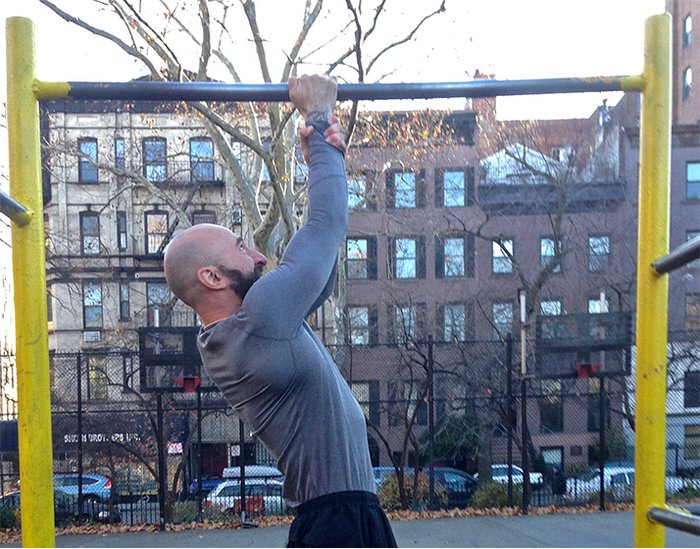
You can also perform a self-assist by holding the wrist of your pulling arm with the hand of your secondary arm.
The first method is what's often known as an "archer" pull-up. For this variant, begin like you're about to do a wide-grip pull-up, but pull your entire body toward one hand while the opposite arm stays straight. This forces your pulling arm to do most of the work, yet allows you to assist yourself as needed.
You can also perform a self-assist by holding the wrist of your pulling arm with the hand of your secondary arm. As I mentioned earlier, this is sometimes known as a "one-handed" chin-up. Your primary arm is the only one gripping the bar, but your secondary arm can still assist with pulling. Over time, progressively lower your assisting hand down toward your elbow. The farther from your wrist you go, the more work your primary arm will have to do. Eventually, you won't need it at all!
Programming and Frequency
Because the one-arm pull-up is a very intense move, you have to be careful not to overdo it. Not only will beginning your one-arm pull-up training give a shock to your muscles, it will also rock your connective tissue and central nervous system.
One-arm pull-up training can be very stressful on the elbow and shoulder joints in particular. Tendinitis is a bitch, and you've got to respect your body or you will pay the price. As such, I recommend practicing these progressions just one or two days per week for the first few weeks, eventually building to three days per week at most.
I'd also recommend keeping your volume low. Think of your one-arm pull-up training almost like training for a one-rep max in a heavy barbell lift. You can't do it all the time or you'll burn yourself out!
Here's an example of what your first few one-arm pull-up training sessions might look like, assuming you can already do 15 strict pull-ups.

BodyFit
$6.99/month- 2,500+ expert-created single workouts
- 3,500+ how-to exercise videos
- Detailed workout instruction
- Step-by-step workout tips
- Training at gym or at home
- Access to Workout Plans
- Access to Bodyfit App
- Store Discounts
Already have a Bodybuilding.com account with BodyFit? Sign In

What comes with BodyFit?

- Instructional Videos
Don't risk doing a workout improperly! Avoid injury and keep your form in check with in-depth instructional videos.

- How-to Images
View our enormous library of workout photos and see exactly how each exercise should be done before you give it a shot.

- Step-by-Step Instructions
Quickly read through our step-by-step directions to ensure you're doing each workout correctly the first time, every time.
Once you're done, finish off with whatever exercises you would otherwise do, such as dips, presses, or hanging leg raises.
The Winding Path to the Bar
Due to the lopsided nature of using just one arm to pull yourself, some trunk rotation may be unavoidable when performing a one-arm pull-up. Your body will naturally twist as you go up. In the beginning, you should use this to your advantage, and practice turning in toward the bar as you pull. This will cause your grip to rotate from an overhand to an underhand position as you ascend.
When a one-arm pull-up is performed on gymnastic rings, the ring will rotate to account for this instead.
Eventually, you can work toward performing a one-arm pull-up with less rotation, keeping your hand in a pronated position throughout the whole range of motion.
The Journey of Years
While a one-arm pull-up is definitely achievable, it won't come easily. It's a tough nut to crack, and training for it can be a humbling experience. Even if you're already strong, learning the one-arm pull-up requires lots of patience and skill-specific practice.
Once I made it my mission to learn this feat, it still took me nearly three years to achieve my first rep. In the time since, the one-arm pull-up remains elusive. Some days I'm able to perform a rep or two without any trouble. Other days, I'm barely able to pull myself halfway to the bar.
Of all the lessons I've learned during my time training for this remarkable feat, the one lesson I'm reminded of again and again is to respect the journey and be patient. The one-arm pull-up is a show of pound-for-pound prowess unlike any other. Only those who possess the rare combination of patience, strength, and determination have a chance to join the ranks of the elite men and women who've performed a pull-up with just one arm. Are you up for the challenge?
For more information, check out Al's book and DVD, "Raising The Bar."


